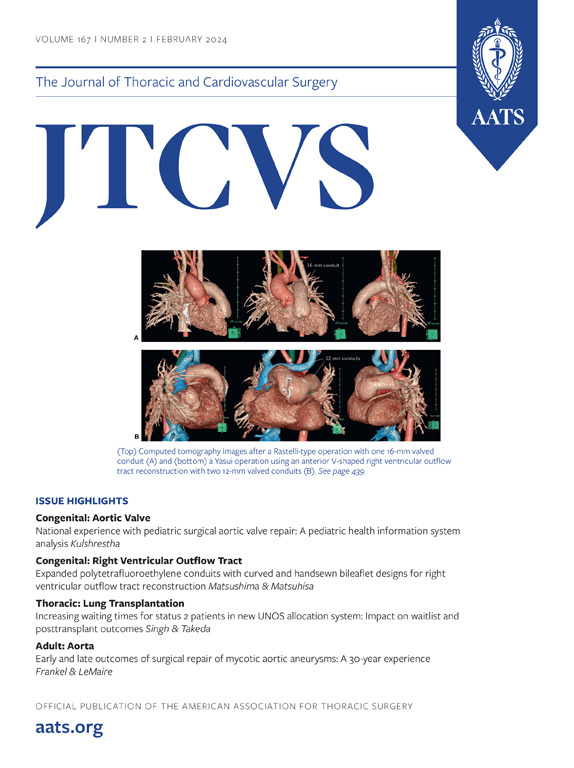用于高危肺结节恶性程度分类的无细胞 DNA 检测。
IF 4.9
1区 医学
Q1 CARDIAC & CARDIOVASCULAR SYSTEMS
Journal of Thoracic and Cardiovascular Surgery
Pub Date : 2024-11-01
DOI:10.1016/j.jtcvs.2024.04.026
引用次数: 0
摘要
目的 虽然低剂量计算机断层扫描已被证实能有效降低肺癌特异性死亡率,但手术切除的高危肺部结节中仍有相当一部分经病理证实为良性。我们招募了 307 名接受根治性手术的高危肺部结节患者,病理证实恶性和良性肺部病变的病例分别为 247 例和 60 例。手术前采集了每位患者的血浆样本,并进行了低深度(5×)全基因组测序。我们提取了无细胞DNA特征,并确定了放射组特征。我们利用数据建立了恶性肿瘤分类模型,并用 2 个独立的肺结节队列进一步验证了模型。结果在研究队列中,我们使用一种特征的模型能够以 0.69 至 0.91 的曲线下面积指标区分肺癌和良性肺结节。整合所有 5 个使用无细胞 DNA 图谱的基础模型后,基于无细胞 DNA 的集合模型在研究队列中的曲线下面积为 0.95(95% CI,0.92-0.97),在验证队列中的曲线下面积为 0.98(95% CI,0.96-1.00)。当特异性为 95.0% 时,研究队列中的灵敏度达到 80.0%。在相同的阈值下,两个验证队列的特异性和灵敏度表现相似。结论基于无细胞 DNA 图谱的方法是一种有效的无创工具,可用于区分恶性肿瘤和高风险但病理上良性的肺结节。本文章由计算机程序翻译,如有差异,请以英文原文为准。
Cell-free DNA assay for malignancy classification of high-risk lung nodules
Objective
Although low-dose computed tomography has been proven effective to reduce lung cancer–specific mortality, a considerable proportion of surgically resected high-risk lung nodules were still confirmed pathologically benign. There is an unmet need of a novel method for malignancy classification in lung nodules.
Methods
We recruited 307 patients with high-risk lung nodules who underwent curative surgery, and 247 and 60 cases were pathologically confirmed malignant and benign lung lesions, respectively. Plasma samples from each patient were collected before surgery and performed low-depth (5×) whole-genome sequencing. We extracted cell-free DNA characteristics and determined radiomic features. We built models to classify the malignancy using our data and further validated models with 2 independent lung nodule cohorts.
Results
Our models using one type of profile were able to distinguish lung cancer and benign lung nodules at an area under the curve metrics of 0.69 to 0.91 in the study cohort. Integrating all the 5 base models using cell-free DNA profiles, the cell-free DNA–based ensemble model achieved an area under the curve of 0.95 (95% CI, 0.92-0.97) in the study cohort and 0.98 (95% CI, 0.96-1.00) in the validation cohort. At a specificity of 95.0%, the sensitivity reached 80.0% in the study cohort. With the same threshold, the specificity and sensitivity had similar performances in both validation cohorts. Furthermore, the performance of area under the curve reached 0.97 in both the study and validation cohorts when considering the radiomic profile.
Conclusions
The cell-free DNA profiles-based method is an efficient noninvasive tool to distinguish malignancies and high-risk but pathologically benign lung nodules.
求助全文
通过发布文献求助,成功后即可免费获取论文全文。
去求助
来源期刊
CiteScore
11.20
自引率
10.00%
发文量
1079
审稿时长
68 days
期刊介绍:
The Journal of Thoracic and Cardiovascular Surgery presents original, peer-reviewed articles on diseases of the heart, great vessels, lungs and thorax with emphasis on surgical interventions. An official publication of The American Association for Thoracic Surgery and The Western Thoracic Surgical Association, the Journal focuses on techniques and developments in acquired cardiac surgery, congenital cardiac repair, thoracic procedures, heart and lung transplantation, mechanical circulatory support and other procedures.

 求助内容:
求助内容: 应助结果提醒方式:
应助结果提醒方式:


